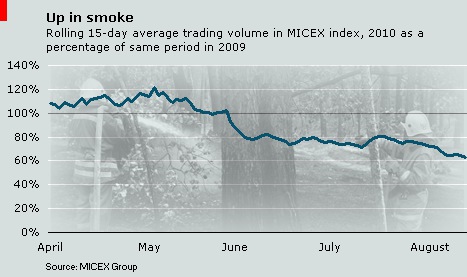You are currently browsing the tag archive for the ‘Russia’ tag.
Capital flight is in the news, usually in the context of investors exiting countries suffering from political instability, as in the Middle East and North Africa, or economic malaise, as in the euro area’s troubled periphery. But robust capital outflows are also making headlines in Russia, with the latest statistics from the central bank showing a US$21.3bn outflow in the first quarter.

A number of factors are cited when explaining the outflow, which was 45% larger than the outflow recorded in the first quarter last year. There are technical and seasonal factors, some say. Others take a dimmer view, noting a general unease among investors regarding the country’s business environment and political uncertainty during the run-up to the presidential election in March next year. Another important factor now being discussed, with some encouraging implications, is the development of rouble-denominated capital markets. Falling interest rates and a growing appetite for local-currency financing has led more Russian companies to borrow in roubles in order to repay foreign debts.
Russia’s economic recovery—now further bolstered by high oil prices—has not been accompanied by an influx of foreign capital. At the same time, this disappointing performance is balanced by the prospect of deeper local capital markets.
Sberbank, by far Russia’s largest bank, reported quarterly earnings today. Its net profit in the first nine months of the year, Rb109.6bn (US$3.5bn), is more than ten times the total in the previous year. A steep fall in provisions helped, as did a rise in fee and commission-based income.

Russia faces many daunting challenges as it recovers from a severe recession. But one important thing it has going for it—and a crucial advantage in relation to other large economies—is that it will not suffer from the need to deleverage huge volumes of private debt. Since the start of the year, Sberbank has grown its loan portfolio by nearly 8%, with similar rises recorded for both corporate and consumer loans. Net interest income, however, is 4% down on the previous year, thanks to falling interest rates and “competition for good borrowers”, the bank said. Struggling to serve rising demand from borrowers is nonetheless a challenge that many other banks would welcome.
It wasn’t that long ago that fears of a flight in deposits at Russian banks reached fever pitch. Sour loans and a rouble rout threatened to push lenders to the wall. The government pledged US$200bn in support, if needed.
In the end, a full-scale banking crisis was avoided, although a number of smaller banks failed. The survivors—particularly at the larger end of the scale—are now performing admirably, especially considering their recent travails. Reflecting both renewed confidence in the banking system and a lack of appealing alternatives, deposits are climbing steadily even as interest rates are cut. Russia’s Deposit Insurance Agency reckons that bank deposits will grow by 25-30% this year.

Soaring temperatures and raging wildfires are making life in Moscow difficult. The effects are being felt on the country’s stock and bond exchanges, as “bankers flee Moscow to escape acrid smoke from wildfires” around Russia’s financial capital. Indeed, the average trading volume in the benchmark MICEX index now stands at around 60% of the levels seen at this time last year.

Last week, Russia’s largest bank, Sberbank, announced that it would cut 20%-25% of its workforce over the next five years.
 Banks shedding staff is nothing new, but the numbers involved at Sberbank continue to generate interest. The bank employs around 258,000 workers, so the deepest announced cut could involve more than 64,000 people, enough to staff a decent-sized bank in itself. But even after such a drastic cull, the Russian lender will continue to employ far more people relative to the size of its balance sheet than most major banks.
Banks shedding staff is nothing new, but the numbers involved at Sberbank continue to generate interest. The bank employs around 258,000 workers, so the deepest announced cut could involve more than 64,000 people, enough to staff a decent-sized bank in itself. But even after such a drastic cull, the Russian lender will continue to employ far more people relative to the size of its balance sheet than most major banks.

